1.2因特网信息交流与网络安全-教科版高中信息技术选修三教案
- 格式:docx
- 大小:21.90 KB
- 文档页数:5
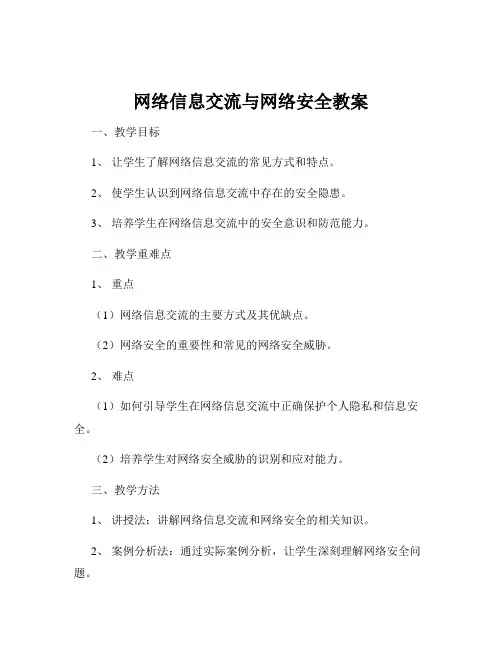
网络信息交流与网络安全教案一、教学目标1、让学生了解网络信息交流的常见方式和特点。
2、使学生认识到网络信息交流中存在的安全隐患。
3、培养学生在网络信息交流中的安全意识和防范能力。
二、教学重难点1、重点(1)网络信息交流的主要方式及其优缺点。
(2)网络安全的重要性和常见的网络安全威胁。
2、难点(1)如何引导学生在网络信息交流中正确保护个人隐私和信息安全。
(2)培养学生对网络安全威胁的识别和应对能力。
三、教学方法1、讲授法:讲解网络信息交流和网络安全的相关知识。
2、案例分析法:通过实际案例分析,让学生深刻理解网络安全问题。
3、讨论法:组织学生讨论网络信息交流中的安全问题,促进学生思考和交流。
四、教学过程(一)导入通过提问引导学生思考网络信息交流在日常生活中的应用,如:“同学们,你们平时都通过哪些方式在网络上与他人交流呢?”从而引出本节课的主题——网络信息交流与网络安全。
(二)网络信息交流的方式1、电子邮件介绍电子邮件的使用方法和特点,如便捷、快速、可传递大量信息等,但也存在垃圾邮件、病毒邮件等安全风险。
2、即时通讯工具讲解常见的即时通讯工具,如微信、QQ 等,它们的实时性和互动性强,但可能会遭遇诈骗、个人信息泄露等问题。
3、社交网络平台以微博、抖音等为例,说明社交网络平台可以让用户分享生活、获取信息,但也容易导致隐私暴露、网络暴力等情况。
(三)网络信息交流中的安全隐患1、个人信息泄露通过案例分析,如用户在不明网站填写个人信息导致信息被非法获取,让学生了解个人信息泄露的危害和途径。
2、网络诈骗讲解常见的网络诈骗手段,如虚假中奖信息、网络购物诈骗等,提醒学生提高警惕。
3、恶意软件和病毒介绍恶意软件和病毒的传播方式和危害,如窃取用户数据、破坏系统等。
(四)网络安全的防范措施1、增强密码安全教导学生设置复杂且独特的密码,并定期更换。
2、谨慎分享个人信息提醒学生在网络交流中不要随意透露敏感信息,如身份证号、银行卡号等。
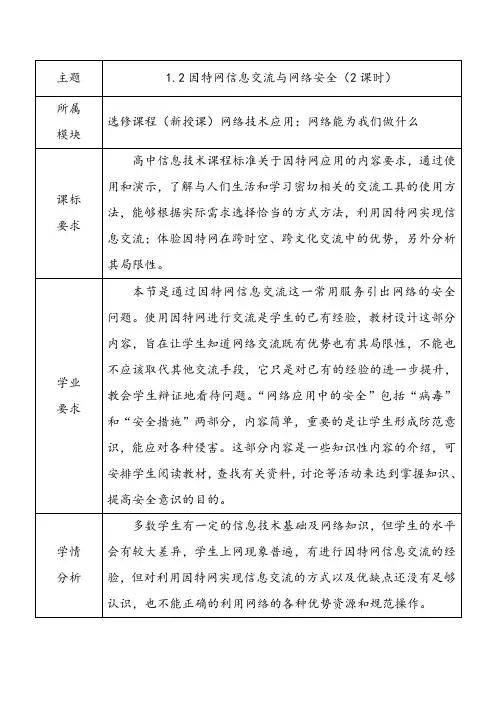
提项目任务一:因特网信息交流
不同通信交流手段各有特
色,也各有应用,同学们应掌握
各种不同的交流手段,并在使用
中去体验比较。
但要注意,因特
网交流工具不能替代其他的交流
手段,要恰当地使用各种信息交
流工具,使其更好地服务学习和
生活。
可行性方案:张晓和姐姐两
人同时空闲通过网络视频方式解
决数学问题,一方忙碌时通过邮
件,QQ留言,微信语音留言等网
络交流工具解决问题
知道信息交流
方式的变化,
以及因特网信
息交流工具的
优点,体会网
络在今天生活
中的作用。
在
一定范围内展
示、交流自己
的项目方案。
项项目二任务:网络应用中的安全
1.引起安全性问题的人及意图
2.计算机网络病毒
计算机病毒是指编制或者在计算
机程序中插入破坏计算机功能或
者毁坏数据,影响计算机使用,
并能自我复制的一组计算机指令
或者程序代码。
来源:电子邮件,下载文件,聊
天工具,Web浏览器等。
特点:可传播性、可执行性、破
坏性、可触发性,感染速的快、
扩散面广、难于彻底清除、破坏
性大等。
3.计算机中毒一般症状
计算机中毒的表现:内存不
够、无法启动、运行速度非常慢、
死机,反复重启等
了解病毒、防
火墙、加密技
术等网络安全
方面的知识,
知道保护网络
信息安全的措
施,并提高防
范意识。
教学评价量规。
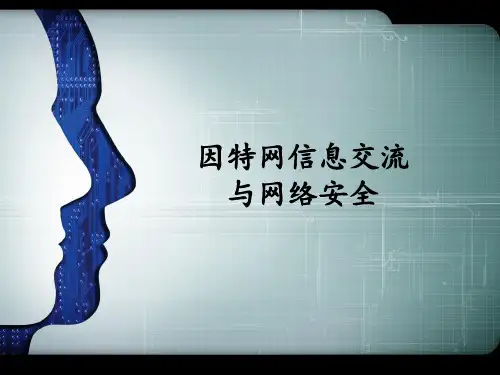
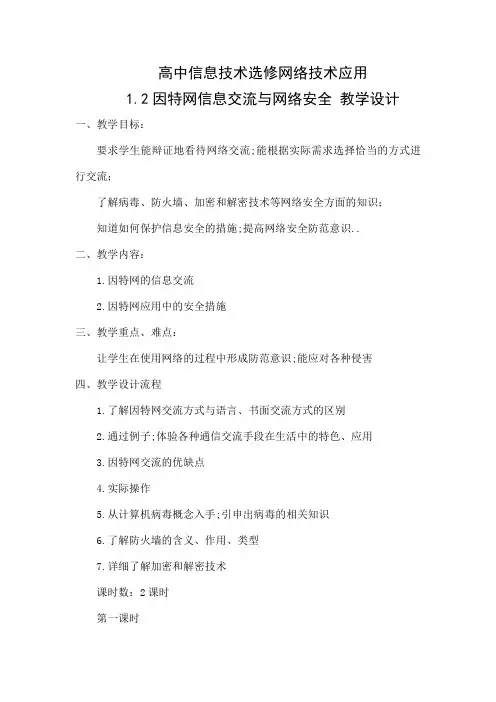
高中信息技术选修网络技术应用1.2因特网信息交流与网络安全教学设计一、教学目标:要求学生能辩证地看待网络交流;能根据实际需求选择恰当的方式进行交流;了解病毒、防火墙、加密和解密技术等网络安全方面的知识;知道如何保护信息安全的措施;提高网络安全防范意识..二、教学内容:1.因特网的信息交流2.因特网应用中的安全措施三、教学重点、难点:让学生在使用网络的过程中形成防范意识;能应对各种侵害四、教学设计流程1.了解因特网交流方式与语言、书面交流方式的区别2.通过例子;体验各种通信交流手段在生活中的特色、应用3.因特网交流的优缺点4.实际操作5.从计算机病毒概念入手;引申出病毒的相关知识6.了解防火墙的含义、作用、类型7.详细了解加密和解密技术课时数:2课时第一课时回顾:什么是信息古进修的人们交流信息的方式有哪些一、因特网的信息交流1.语言和书面交流方式的特点:①有一定的指向性②交往的范围、目的比较明确2.基于因特网的交流方式3.因特网在跨时空、跨文化交流方面的优势与局限优势:①既闻其声;又见其人②打破时间、空间的限制③超越年龄、资历、知识等的隔阂④人们可以平等地相互探讨感兴趣的问题⑤在不同时间、地点;可以实现资源共享⑥因特网允许不同政治、经济和文化背景的人进行双向的交流局限:①受到技术限制②我国的媒体受政党统治;不能随意发表演说;外国的媒体监督政党4.技术没有国籍之分;技术可以使我们的交流受到限制..例:深圳的技术人员在工作上遇到难题;需要向北京的技术人员请教..他如何选择使用各种信息交流工具进行沟通与合作呢信息交流工具选择与否理由交通工具否不经济书信来往否沟通效率低;时间长电话否语言障碍;解释不清楚发传真否费时;需要再重新把程序录入计算机远程监控可以远程监控计算机E-mail 可以调试好再发送练习:1.你使用过电子邮件、ICQ等通信交流工具的文件传输功能吗说出这两种工具在传输方面的特点..E-mail:受邮箱空间的限制;一方在线可以传输文件;另一方可以不在线..传输的文件可以是文本、声音、图片像、视频文件、可执行文件等ICQ:受速度大小的限制;两方必须同时在线才能传输文件..2.因特网交流具有的优缺点优点:可以跨民族、政治等交流;低廉;速度快..缺点:不安全性黑客一簇、被盗、技术不成熟安排任务任务1:启动杀毒软件;观察该台电脑是否中毒为什么会这样任务2:打开你的;修改号码;再重新登录..任务3:打开你的E-mail;查看邮箱中是否有垃圾邮件如果有;你怎么办任务4:上网搜索相关资源:为什么我的电脑会中毒任务5:你听说过哪些杀毒软件二、网络应用中的安全1.计算机网络病毒1概念:编制或者在计算机程序中插入破坏计算机功能或者毁坏数据;影响计算机使用;并能自我复制的一组计算机指令或者程序代码..从概念中可以了解的内容:载体:计算机传染因素:网络、可移动磁盘2病毒传播方式病毒直接从有盘站拷贝到服务器中;病毒先传染工作站;在工作站内存驻留;在病毒运行时直接通过映像路径传染到服务器中;病毒先传染工作站;在工作站内存驻留;等运行网络盘内程序时再传染给服务器;如果远程工作站被病毒侵入;病毒也可以通过通讯中数据交换进入网络服务器中..3病毒的特点:传染性、潜伏性、可传播性、可执行性、破坏性、可触发性、复制性、感染速度快、扩散面广、难于清除、破坏性大、不可预见性、寄生性4病毒传播的过程当达到某种条件是即被激活;通过修改其他程序的方法将自己的精确拷贝或者可能演化的形式放入其他程序中;从而感染它们对计算机资源进行破坏..5病毒类型计算机蠕虫的特点:与正常程序争夺计算机时间资源;无破坏性梅莉莎病毒:会传染其他程序的程序特洛伊木马:一般隐藏在正常程序中逻辑炸弹:受特定条件限制病毒名称病毒类型传播渠道表现形式或危害冲击波蠕虫病毒利用微软网络接口漏洞进行传播系统反复重启;无法浏览网页;系统资源被大量占用..在任务管理器里有一个叫“msblast.exe”的进程在运行n不能复制、粘贴;有时出现应用程序;比如Word异常..6计算机中毒的表现:内存不够、无法启动、运行速度非常慢、死机等2.认识防火墙1什么是防火墙防火墙是一个或一组网络设备;它架在两个或两个以上的网络之间;用来加强访问控制;免得一个网络受到来自另一个网络的攻击..2防火墙的作用:控制着访问网络的权限;只允许特许用户进出网络..3类型:安排任务任务1:启动杀毒软件;观察该台电脑是否中毒为什么样会这样任务2:打开你的;修改号码;再重新登录..任务3:打开你的e-mail;查看邮箱中是否有垃圾邮件如果有;你怎么办任务4:上网搜索相关资源:为什么我的电脑会中毒任务5:你听说过哪些杀毒软件任务6:你对黑客了解多少。
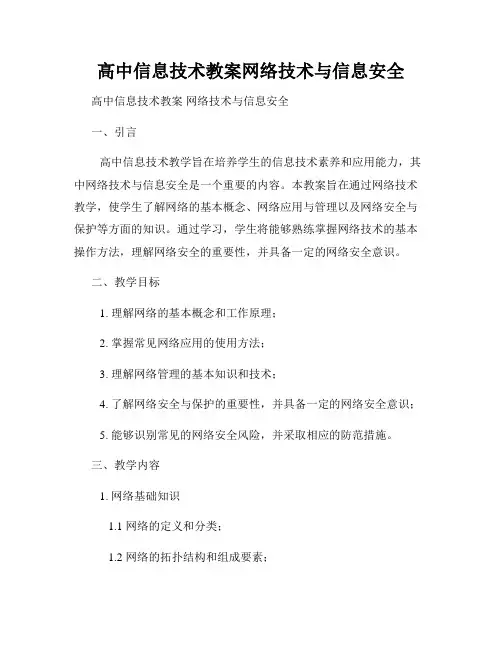
高中信息技术教案网络技术与信息安全高中信息技术教案网络技术与信息安全一、引言高中信息技术教学旨在培养学生的信息技术素养和应用能力,其中网络技术与信息安全是一个重要的内容。
本教案旨在通过网络技术教学,使学生了解网络的基本概念、网络应用与管理以及网络安全与保护等方面的知识。
通过学习,学生将能够熟练掌握网络技术的基本操作方法,理解网络安全的重要性,并具备一定的网络安全意识。
二、教学目标1. 理解网络的基本概念和工作原理;2. 掌握常见网络应用的使用方法;3. 理解网络管理的基本知识和技术;4. 了解网络安全与保护的重要性,并具备一定的网络安全意识;5. 能够识别常见的网络安全风险,并采取相应的防范措施。
三、教学内容1. 网络基础知识1.1 网络的定义和分类;1.2 网络的拓扑结构和组成要素;1.3 网络的工作原理和通信过程;1.4 网络的发展历程和现状。
2. 网络应用与管理2.1 网页浏览和搜索技巧;2.2 电子邮件的发送和接收;2.3 网络视频和音乐的在线播放;2.4 网络游戏和社交媒体的使用方法;2.5 网络资源的上传和下载;2.6 网络管理的基本知识和技术。
3. 网络安全与保护3.1 网络安全的定义和重要性;3.2 常见的网络安全威胁和攻击手段;3.3 个人信息保护和隐私安全;3.4 安全浏览和下载的技巧;3.5 网络账户和密码的安全管理;3.6 网络安全防范措施和常见故障的排除。
四、教学方法与手段1. 授课法:通过系统的课堂讲解,向学生介绍网络技术的基本概念、工作原理、应用和管理知识。
2. 实验法:设计实际案例和实验任务,让学生动手操作,提高实际应用能力。
3. 讨论法:组织学生进行小组讨论,鼓励学生表达自己的观点和思考,促进学生的互动和合作。
4. 观察法:引导学生观察和分析网络安全事件,培养学生的观察力和分析思维。
五、教学过程1. 网络基础知识教学1.1 介绍网络的定义和分类,让学生了解互联网和局域网的概念;1.2 给出网络的拓扑结构和组成要素的示意图,让学生了解网络的基本构成;1.3 通过模拟实验和案例分析,让学生理解网络的工作原理和通信过程;1.4 使用多媒体资料和图表,介绍网络的发展历程和现状。
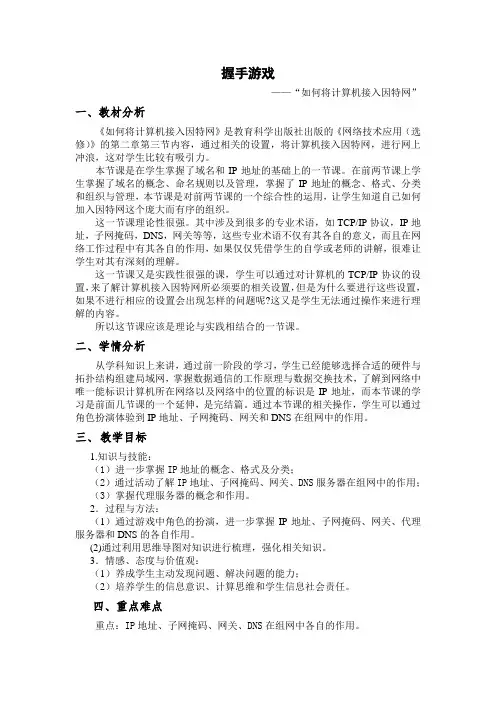
握手游戏——“如何将计算机接入因特网”一、教材分析《如何将计算机接入因特网》是教育科学出版社出版的《网络技术应用(选修)》的第二章第三节内容,通过相关的设置,将计算机接入因特网,进行网上冲浪,这对学生比较有吸引力。
本节课是在学生掌握了域名和IP地址的基础上的一节课。
在前两节课上学生掌握了域名的概念、命名规则以及管理,掌握了IP地址的概念、格式、分类和组织与管理,本节课是对前两节课的一个综合性的运用,让学生知道自己如何加入因特网这个庞大而有序的组织。
这一节课理论性很强。
其中涉及到很多的专业术语,如TCP/IP协议,IP地址,子网掩码,DNS,网关等等,这些专业术语不仅有其各自的意义,而且在网络工作过程中有其各自的作用,如果仅仅凭借学生的自学或老师的讲解,很难让学生对其有深刻的理解。
这一节课又是实践性很强的课,学生可以通过对计算机的TCP/IP协议的设置,来了解计算机接入因特网所必须要的相关设置,但是为什么要进行这些设置,如果不进行相应的设置会出现怎样的问题呢?这又是学生无法通过操作来进行理解的内容。
所以这节课应该是理论与实践相结合的一节课。
二、学情分析从学科知识上来讲,通过前一阶段的学习,学生已经能够选择合适的硬件与拓扑结构组建局域网,掌握数据通信的工作原理与数据交换技术,了解到网络中唯一能标识计算机所在网络以及网络中的位置的标识是IP地址,而本节课的学习是前面几节课的一个延伸,是完结篇。
通过本节课的相关操作,学生可以通过角色扮演体验到IP地址、子网掩码、网关和DNS在组网中的作用。
三、教学目标1.知识与技能:(1)进一步掌握IP地址的概念、格式及分类;(2)通过活动了解IP地址、子网掩码、网关、DNS服务器在组网中的作用;(3)掌握代理服务器的概念和作用。
2.过程与方法:(1)通过游戏中角色的扮演,进一步掌握IP地址、子网掩码、网关、代理服务器和DNS的各自作用。
(2)通过利用思维导图对知识进行梳理,强化相关知识。
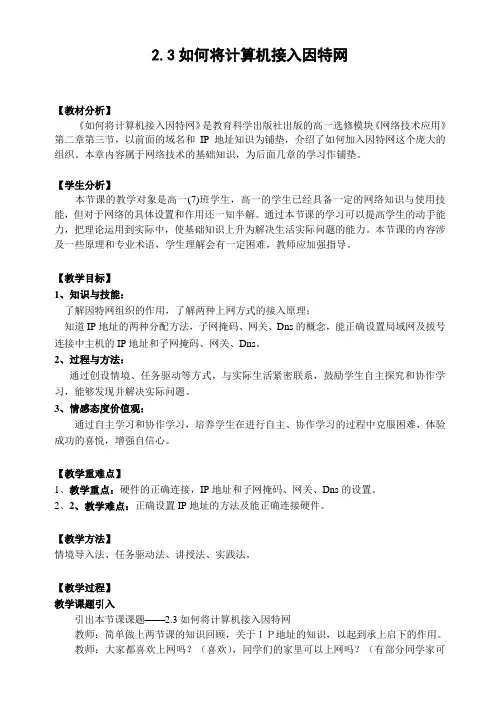
2.3如何将计算机接入因特网【教材分析】《如何将计算机接入因特网》是教育科学出版社出版的高一选修模块《网络技术应用》第二章第三节,以前面的域名和IP地址知识为铺垫,介绍了如何加入因特网这个庞大的组织。
本章内容属于网络技术的基础知识,为后面几章的学习作铺垫。
【学生分析】本节课的教学对象是高一(7)班学生,高一的学生已经具备一定的网络知识与使用技能,但对于网络的具体设置和作用还一知半解。
通过本节课的学习可以提高学生的动手能力,把理论运用到实际中,使基础知识上升为解决生活实际问题的能力。
本节课的内容涉及一些原理和专业术语,学生理解会有一定困难,教师应加强指导。
【教学目标】1、知识与技能:了解因特网组织的作用,了解两种上网方式的接入原理;知道IP地址的两种分配方法,子网掩码、网关、Dns的概念,能正确设置局域网及拔号连接中主机的IP地址和子网掩码、网关、Dns。
2、过程与方法:通过创设情境、任务驱动等方式,与实际生活紧密联系,鼓励学生自主探究和协作学习,能够发现并解决实际问题。
3、情感态度价值观:通过自主学习和协作学习,培养学生在进行自主、协作学习的过程中克服困难,体验成功的喜悦,增强自信心。
【教学重难点】1、教学重点:硬件的正确连接,IP地址和子网掩码、网关、Dns的设置。
2、2、教学难点:正确设置IP地址的方法及能正确连接硬件。
【教学方法】情境导入法、任务驱动法、讲授法、实践法。
【教学过程】教学课题引入引出本节课课题——2.3如何将计算机接入因特网教师:简单做上两节课的知识回顾,关于IP地址的知识,以起到承上启下的作用。
教师:大家都喜欢上网吗?(喜欢),同学们的家里可以上网吗?(有部分同学家可以上网)如果你家里买来一台电脑,想上网怎么办?,同学们可以自己动手接入因特网吗?学生回答:网线、猫、电信、拨号宽带连接等。
教师:刚刚同学们提到了很多与上网有关的关键词,比如猫、电信等,甚至还有同学办过家里的宽带,那么究竟怎样才能顺利实现上网,今天我们一起来学习《2.3如何将计算机接入因特网》。
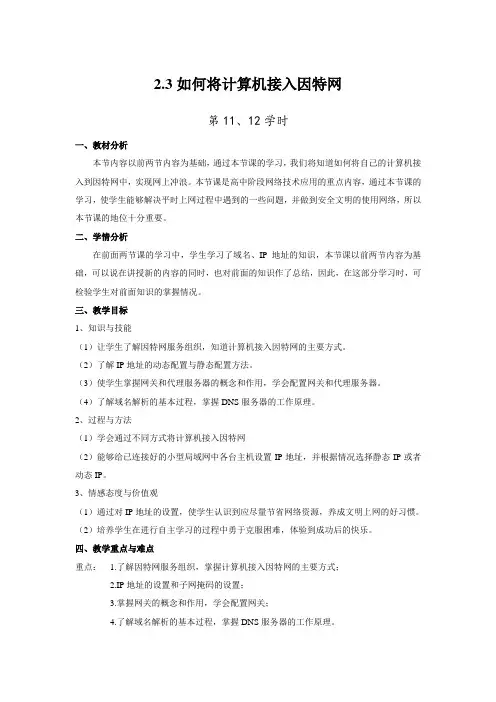
2.3如何将计算机接入因特网第11、12学时一、教材分析本节内容以前两节内容为基础,通过本节课的学习,我们将知道如何将自己的计算机接入到因特网中,实现网上冲浪。
本节课是高中阶段网络技术应用的重点内容,通过本节课的学习,使学生能够解决平时上网过程中遇到的一些问题,并做到安全文明的使用网络,所以本节课的地位十分重要。
二、学情分析在前面两节课的学习中,学生学习了域名、IP地址的知识,本节课以前两节内容为基础,可以说在讲授新的内容的同时,也对前面的知识作了总结,因此,在这部分学习时,可检验学生对前面知识的掌握情况。
三、教学目标1、知识与技能(1)让学生了解因特网服务组织,知道计算机接入因特网的主要方式。
(2)了解IP地址的动态配置与静态配置方法。
(3)使学生掌握网关和代理服务器的概念和作用,学会配置网关和代理服务器。
(4)了解域名解析的基本过程,掌握DNS服务器的工作原理。
2、过程与方法(1)学会通过不同方式将计算机接入因特网(2)能够给已连接好的小型局域网中各台主机设置IP地址,并根据情况选择静态IP或者动态IP。
3、情感态度与价值观(1)通过对IP地址的设置,使学生认识到应尽量节省网络资源,养成文明上网的好习惯。
(2)培养学生在进行自主学习的过程中勇于克服困难,体验到成功后的快乐。
四、教学重点与难点重点: 1.了解因特网服务组织,掌握计算机接入因特网的主要方式;2.IP地址的设置和子网掩码的设置;3.掌握网关的概念和作用,学会配置网关;4.了解域名解析的基本过程,掌握DNS服务器的工作原理。
难点: 1.IP地址与子网掩码的设置;2.网关、DNS功能分析与设置。
五、教学策略根据教材特点将教学法确定为:讲授法、任务驱动、实践操作法、小组共同探讨。
六、教学过程一、因特网服务组织(自主学习)1.通过这部分的学习,学生知道为什么家里上网要向电信交钱ISP:因特网服务提供商(Internet ServerProvider)ICP:因特网内容提供商(Internet Content Provider)ASP:因特网应用服务提供商(Application Server Provider)国内著名的ISP有:中国公用计算机互联网(CHINANET)中国教育和科研计算机网(CERNET)中国电信(163、169)中国联通(UNINET中国金桥信息网(CHINAGBN)2.两种上网方式计算机要加入因特网时,首先选择合适的ISP,一般来说,家庭上网方式为MODEM、ISDN、ADSL方式,单位企业等有多台计算机需同时上网,则通过局域网接入因特网。
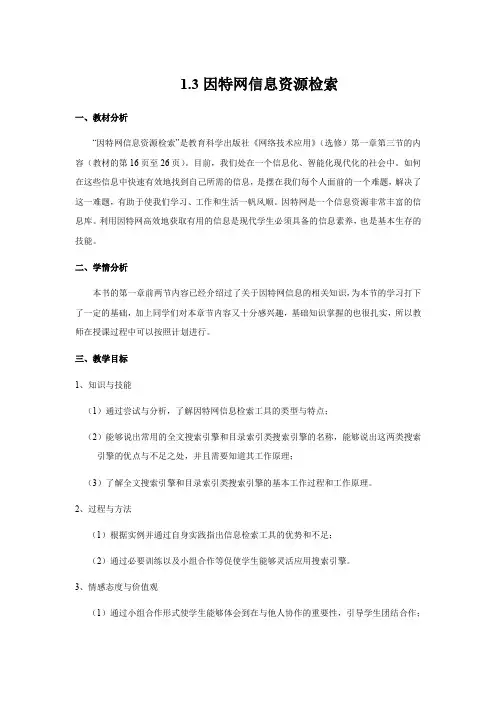
1.3因特网信息资源检索一、教材分析“因特网信息资源检索”是教育科学出版社《网络技术应用》(选修)第一章第三节的内容(教材的第16页至26页)。
目前,我们处在一个信息化、智能化现代化的社会中。
如何在这些信息中快速有效地找到自己所需的信息,是摆在我们每个人面前的一个难题,解决了这一难题,有助于使我们学习、工作和生活一帆风顺。
因特网是一个信息资源非常丰富的信息库。
利用因特网高效地获取有用的信息是现代学生必须具备的信息素养,也是基本生存的技能。
二、学情分析本书的第一章前两节内容已经介绍过了关于因特网信息的相关知识,为本节的学习打下了一定的基础,加上同学们对本章节内容又十分感兴趣,基础知识掌握的也很扎实,所以教师在授课过程中可以按照计划进行。
三、教学目标1、知识与技能(1)通过尝试与分析,了解因特网信息检索工具的类型与特点;(2)能够说出常用的全文搜索引擎和目录索引类搜索引擎的名称,能够说出这两类搜索引擎的优点与不足之处,并且需要知道其工作原理;(3)了解全文搜索引擎和目录索引类搜索引擎的基本工作过程和工作原理。
2、过程与方法(1)根据实例并通过自身实践指出信息检索工具的优势和不足;(2)通过必要训练以及小组合作等促使学生能够灵活应用搜索引擎。
3、情感态度与价值观(1)通过小组合作形式使学生能够体会到在与他人协作的重要性,引导学生团结合作;(2)通过一些事例,如“两会”等,培养学生关心时政,关爱国家的思想;(3)通过网络中一些事物,通过分析,辨别正伪,培养学生正确的判断能力,进而促进学生形成好的人生价值观。
四、教学重点与难点重点:1.因特网信息检索工具的特点、工作原理和搜索技巧;2.选择合适的信息检索工具高效获取信息。
难点:1.搜索引擎的基本过程和工作原理;2.选择合适的信息检索工具高效获取信息。
五、教学策略根据课改要求结合教材特点将教学方法确定为讲授法、讨论法、直观演示法、任务驱动法、自主学习法。
六、教学过程。
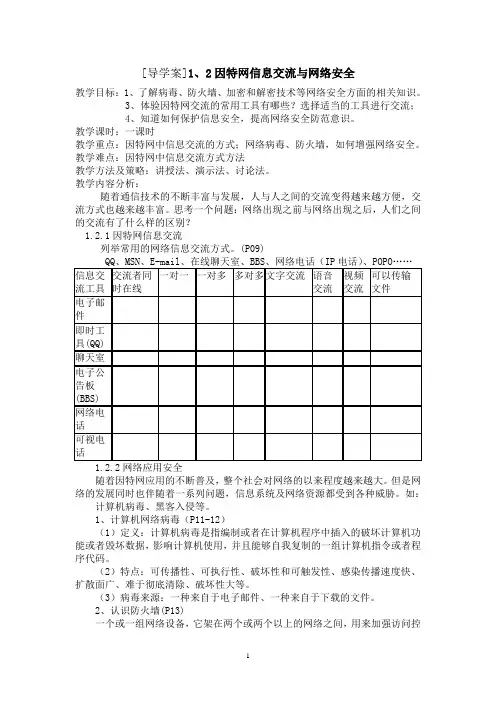
[导学案]1、2因特网信息交流与网络安全教学目标:1、了解病毒、防火墙、加密和解密技术等网络安全方面的相关知识。
3、体验因特网交流的常用工具有哪些?选择适当的工具进行交流;4、知道如何保护信息安全,提高网络安全防范意识。
教学课时:一课时教学重点:因特网中信息交流的方式;网络病毒、防火墙,如何增强网络安全。
教学难点:因特网中信息交流方式方法教学方法及策略:讲授法、演示法、讨论法。
教学内容分析:随着通信技术的不断丰富与发展,人与人之间的交流变得越来越方便,交流方式也越来越丰富。
思考一个问题:网络出现之前与网络出现之后,人们之间的交流有了什么样的区别?1.2.1因特网信息交流列举常用的网络信息交流方式。
(P09)随着因特网应用的不断普及,整个社会对网络的以来程度越来越大。
但是网络的发展同时也伴随着一系列问题,信息系统及网络资源都受到各种威胁。
如:计算机病毒、黑客入侵等。
1、计算机网络病毒(P11-12)(1)定义:计算机病毒是指编制或者在计算机程序中插入的破坏计算机功能或者毁坏数据,影响计算机使用,并且能够自我复制的一组计算机指令或者程序代码。
(2)特点:可传播性、可执行性、破坏性和可触发性、感染传播速度快、扩散面广、难于彻底清除、破坏性大等。
(3)病毒来源:一种来自于电子邮件、一种来自于下载的文件。
2、认识防火墙(P13)一个或一组网络设备,它架在两个或两个以上的网络之间,用来加强访问控制,防止一个网络受到来自另一个网络的攻击。
如果从实现方式上来分,防火墙又分为硬件防火墙和软件防火墙两类。
防火墙(firewall)控制着访问网络的权限、只允许特许用户进出网络。
3、加密、解密技术(P13)为确保网络安全,仅安装防火墙是不够的,还需要采用其他技术,如用户验证、入侵检测、密码技术等。
替换法是一中常见的加密方法。
对计算机加密使用的算法有对称密匙加密算法和公开密匙加密算法两类。
对称密匙使用同意密匙进行加密和解密,又称绘画密匙加密算法。
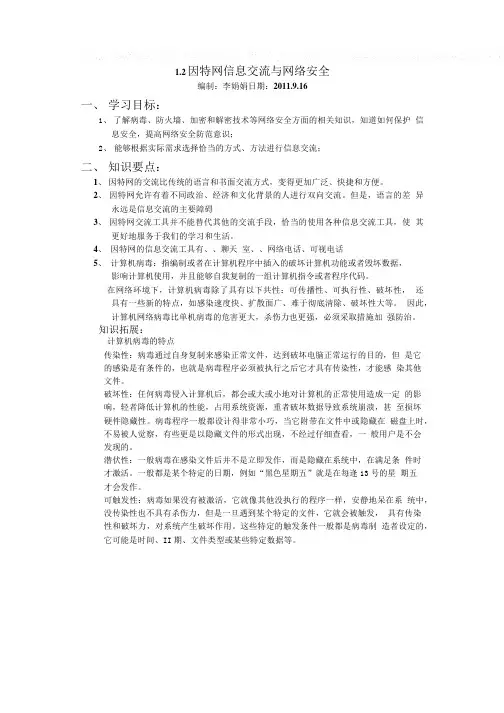
1.2因特网信息交流与网络安全编制:李娟娟日期:2011.9.16一、学习目标:1、了解病毒、防火墙、加密和解密技术等网络安全方面的相关知识,知道如何保护信息安全,提高网络安全防范意识;2、能够根据实际需求选择恰当的方式、方法进行信息交流;二、知识要点:1、因特网的交流比传统的语言和书面交流方式,变得更加广泛、快捷和方便。
2、因特网允许有着不同政治、经济和文化背景的人进行双向交流。
但是,语言的差异永远是信息交流的主要障碍3、因特网交流工具并不能替代其他的交流手段,恰当的使用各种信息交流工具,使其更好地服务于我们的学习和生活。
4、因特网的信息交流工具有、、聊天室、、网络电话、可视电话5、计算机病毒:指编制或者在计算机程序中插入的破坏计算机功能或者毁坏数据,影响计算机使用,并且能够自我复制的一组计算机指令或者程序代码。
在网络环境下,计算机病毒除了具有以下共性:可传播性、可执行性、破坏性,还具有一些新的特点,如感染速度快、扩散面广、难于彻底清除、破坏性大等。
因此,计算机网络病毒比单机病毒的危害更大,杀伤力也更强,必须采取措施加强防治。
知识拓展:计算机病毒的特点传染性:病毒通过自身复制来感染正常文件,达到破坏电脑正常运行的目的,但是它的感染是有条件的,也就是病毒程序必须被执行之后它才具有传染性,才能感染其他文件。
破坏性:任何病毒侵入计算机后,都会或大或小地对计算机的正常使用造成一定的影响,轻者降低计算机的性能,占用系统资源,重者破坏数据导致系统崩溃,甚至损坏硬件隐藏性。
病毒程序一般都设计得非常小巧,当它附带在文件中或隐藏在磁盘上时,不易被人觉察,有些更是以隐藏文件的形式出现,不经过仔细查看,一般用户是不会发现的。
潜伏性:一般病毒在感染文件后并不是立即发作,而是隐藏在系统中,在满足条件时才激活。
一般都是某个特定的日期,例如“黑色星期五”就是在每逢13号的星期五才会发作。
可触发性:病毒如果没有被激活,它就像其他没执行的程序一样,安静地呆在系统中,没传染性也不具有杀伤力,但是一旦遇到某个特定的文件,它就会被触发,具有传染性和破坏力,对系统产生破坏作用。
3.3 因特网上的信息交流模块:高中信息技术选修3 ——网络技术应用年级:高中二年级所用教材版本:广东教育出版社学时数:1非上机时间20 分钟,上机操作时间25 分钟本教学案例参与人员基本信息教学设计一、教学目标1、对熟悉的网络信息交流工具进行比较,了解因特网信息交流服务的基本类型与特点。
2、能描述C/S,B/S结构的特点,并能根据实际需求选择恰当的交流方式和工具。
3、初步了解因特网信息交流方式的基本工作原理。
二、内容分析本节教学内容主要是对因特网上的信息交流方式进行归纳,介绍因特网信息交流服务的基本工作思想和方法。
通过本节学习,让学生能够根据实际需求选择恰当的方式方法,利用因特网实现信息交流,体验因特网在跨时空、跨文化交流中的优势。
教学重点:1.了解因特网信息交流服务的基本类型、特点与应用领域。
2.C/S结构和B/S结构的概念与特点。
3.实时与非实时交流方式的区别,并能够选择适当的工具进行交流。
教学难点:1.因特网应用服务的主要工作模式。
2.电子邮件的工作原理。
三、学生分析本节课的教学对象是高二的学生,之前他们在信息基础必修(第四章第三节信息的发布与交流)中,学生已经对基本的信息交流方式有了一定的了解,很多同学都有自己的email和qq号,并能通过这些网络工具实现交流的目的。
但他们仅限于简单的聊天,无法解释和解决在使用过程中遇到的疑问,对因特网中信息交流缺乏理论上的支持。
四、教学策略设计1.教学方法:任务驱动法、讲授法2.设计思路:交流是每个人生存的基本需求,而网络给人们提供了更方便的平台。
这节课让学生用他们熟悉的EMAIL和QQ来分别体验非实时与实时信息交流方式的区别。
由于C/S 结构和B/S结构概念比较抽象,学生不易理解,故而在学生活动环节中让学生配置OUTLOOK邮件客户程序,让其对比与WEB MAIL方式的不同,从而让学生能够区分这两种结构,并通过几个选择题加深理解。
五、教学媒体计算机教室PowerPoint课件六、教学过程七、教学反思本节课内容学生兴趣比较高,通过两个任务的设置学生对因特网中信息交流的方式有了更深层次的了解,基本达到了教学任务。